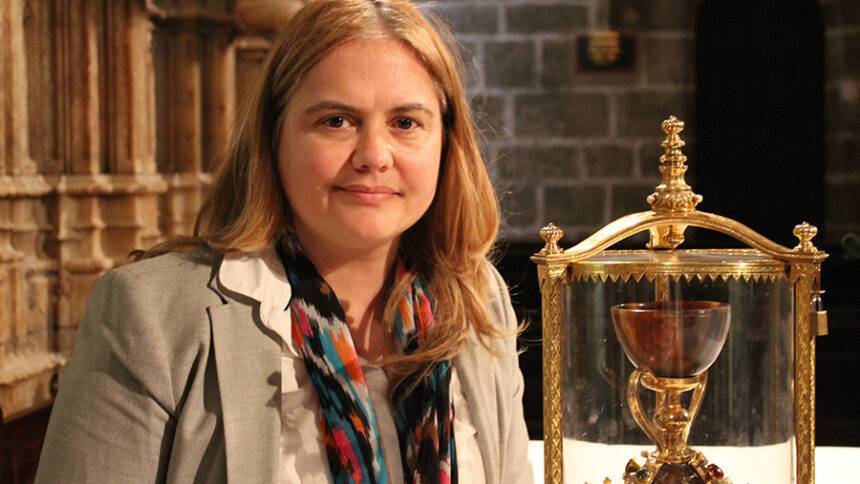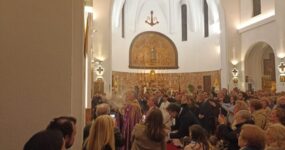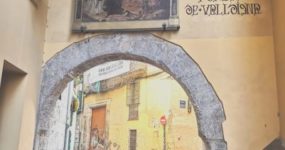24/7 Valencia: Tell us about your background, education and travels…
Dr Ana Mafé García: I studied at a school called Santa María Marianistas in my village of Alboraya- where horchata is made in Valencia. I’ve been well-educated in the Catholic faith. I studied tourism at the official School of Tourism in Madrid and earned my Master’s degree in environmental tourism: Ecotourism at the Polytechnic University of Madrid at the Higher Technical School of Engineers in Montes. I am also a graduate, master, and doctor Cum Laude with international mention in Art History at the University of València. For my research I have travelled abroad to the Middle East: Istanbul and Jerusalem. In Europe I have been to Faro, London and Rome. In Spain, I have been to Córdoba, Navarra, San Juan de la Peña, Jaca, Zaragoza, and to all of the Territory of the Grail in the Valencian Community.
What is the Holy Grail?
The Holy Grail is the most important relic of Christianity. According to tradition, it is the cup from which Jesus Christ drank during The Last Supper. Since 1437 it has been in the Cathedral of Valencia but it was not until 1916 when it was publicly exhibited in its current location. It was previously hidden with other treasures in the cathedral’s reliquary, where the public could not access it.
The Holy Grail is the Holy Chalice of the cathedral of Valencia. The Holy Chalice can be found in the Chapel of the Holy Chalice. This is a magnificent gothic chapel. It was the cathedral’s ancient chapter house. For centuries, it has exhibited the medieval chains of the Port of Marseille on its walls. The chapel features a pew of medieval stone and was where the reception was held for the last Pope who visited Valencia, who was Benedict XVI.
Can you give us a description of the object
The holy chalice is composed of three parts:
– A top part made of stone 4 fingers long (the relic).
– A middle part that is made out of gold in the 11th century that serves to showcase and sustain the ancient relic.
– A base that is decorated in the Carolingian style that visually balances the piece. This is probably from the Fatimid period (8th-9th centuries).
The reliquary is made of gold with the niello technique around the 11th century; this technique was used because the relics couldn’t be touched with their hands. In the Middle Ages, not even kings could touch the relics.
It must be known that the actual relic is only the upper portion of the cup. The rest is what is known in liturgical theology as the “reliquary”. The reliquary is used to show and exhibit the Holy Grail. That is why there are two handles, so the Grail can be lifted. As I mentioned, the base has origins of the Fatimid period, between the 8th and 9th centuries. It is decorated in gold in precious stones in the Carolingian style. There are three types of jewels featured throughout: 28 pearls, 2 rubies, and 2 emeralds. Each symbolizes an aspect related to the Holy Grail in Medieval Times.
Can you tell us about the route the Holy Grail took from Jerusalem to Valencia?
This oral tradition begins with the story of Saint Lawrence when he was about to be martyred by Emperor Valerian (circa 258). Saint Lawrence, instead of surrendering the treasures of the Church to the Emperor, followed the mandate of Pope Sixtus II by saving and separating the treasures of the Church. The relic was escorted from Rome to Osca, the hometown of Saint Lawrence, to safeguard the most precious of treasures: the cup that Jesus used in his last supper. With the Saracen invasion of the Peninsula in the year 711, the inhabitants of Osca and the bishop were safe in the Pyrenees with all of their relics.
Finally, the most holy portion of the holy chalice was kept in a very hidden place, a monastic centre dedicated to San Juan that later became the Royal Pantheon Monastery of San Juan de la Peña. This is the place where the first kings of the crown of Aragon are buried. There, in around the 11th century, the reliquary was added. The reliquary has a golden base and two handles. There is a notarial deed from 1399 that officially explains the provenance of the holy chalice in the archives of the Crown of Aragon.
Since then, the monastery of San Juan de la Peña suffered three devastating fires. From then on, there is documentation such as various inventories of the reliquary of the King of the Crown of Aragon that explain how it arrived at the Cathedral of Valencia. There is also excellent documentary research work done in 2010, by Dr. Catalina Martín Lloris, on this subject.
In the fifteenth century, the city of Valencia was like the New York of the Mediterranean. The king even moved the court of the kingdom of Aragon to the city of Valencia. And on that journey, Alfonso the Magnanimous brought with him all of his royal treasures. Since Valencia was the most important city in the entire Western Mediterranean, the holy relic came to the city.
Later, in the year 1437, the king decided that it was to be guarded in the cathedral for safe-keeping. From 1437 to today the relic has been held in the cathedral and revered without interruption.
What proof do you have that Valencia has the authentic Holy Grail?
In the year of 1960 Dr. Antonio Beltrán, Professor of Archeology at the University of Zaragoza, confirmed that the chalice would have originated between the 2nd century BC and the 1st century BC. The way to date artifacts in Archaeology is through comparison and by “constructive technique”.
The upper cup of the holy chalice is made through a hammer and chisel technique. This technique is no longer used but employs the Roman “lathe” tool which was used at the end of the first century. This technique was used for all of the glasses that we know of from after the time of the Second Hebrew Temple. With this information, we can know the artifact is of Roman and not Hebrew production.
However, we could not find out where the Chalice came from geographically, nor the type of stone of which it is composed. The state contributed the information that the Holy Grail is an entirely Hebrew cup. It has the measurements of four fingers high with a capacity of two and a half rivets. It is classified as Kos Kidush Esther Valencia – 2018. It is a fine, hand-carved glass composed of semi-precious agate gemstone; although, in ancient times they believed it to be of sardius. This stone is linked to the same time as the Second Temple of the pectoral of the High Priest, which represents the tribe of Judah (the same as Jesus) and symbolizes the rule of love. Therefore, we have a Hebrew cup from the Second Temple that represents the tribe of Judah, which in turn reflects the Jewish worldview of the rule of love.
If we consider the scenario recounted in the canonical gospels of the New Testament (the canons of St, Matthew, St. Mark and St. Luke) we discover that on the night of Easter there was “a cup.” This signifies the celebration of the Passover of Jesus. In addition, the Gospel of St. John explains how Jesus spoke of the new commandment that night: love as a currency of exchange between human relationships.
In nine different scenarios, The Holy Chalice fulfills all of the requirements of marrying a physical object (the Holy Chalice – Holy Grail) with the Jewish worldview of 2000 years ago: container made with purifiable material (yes), having ad-hoc Hebrew measurements (yes), of which is close to the figure of Jesus (yes), and is related to the message of Jesus (yes), etc.
Since 2015 and continuing every five years, the Vatican has acknowledged Valencia as a “Jubilee city”. All of this is thanks to the lasting tradition of guarding the sacred relic in the cathedral for so many centuries. The chalice in Valencia is the only relic known as the Holy Grail that the Vatican officially recognizes.
Could you tell us about plans to make an official route?
“El Camino del Santo Grail” is a cultural association that has motivated the idea of making a unique tour in pursuit of the Holy Grail. The trail was started in 2002 by the Guild of the Holy Chalice of Valencia and the Manager of San Juan de la Peña. Since 2002, they have carried out expeditions on foot, horseback, and bicycle. They have published publications in hopes to spread the mission of highlighting the Way of the Holy Grail. The route is a road that runs for 520 km in about 22 days from the old monastery of San Juan de la Peñas to the Cathedral of Valencia. In 2016, the association contacted me and offered me the role of vice-president. I gladly accepted this offer and have since been researching the Holy Chalice for many years.
The grail route is officially known in Valencia as “The Way of the Holy Grail” or simply “The Grail Route.” However, the association also refers to it fondly as “the knowledge route”, and “the path of peace.” The association also issues a pilgrim’s passport for travellers that may be interested in stamping it along the way. In Valencia, “Aula Grail” is a place where you can go to get a certificate of your achievement. “Valten Travel” is an agency that promotes this route through the sale of traditional travel agencies. In accordance with the association, they successfully presented a product brochure of the route in FITUR 2019.
Valencia is the city of the Holy Grail and has a museum dedicated to the holy chalice called Aula Grail. And of course, there is the Grail Route whose project is led by the Turismo Comunidad Valenciana.
What are your hopes for the future?
The association works closely with the Church to ensure that more people visit Valencia every Jubilee year in the hope that the relic becomes better known.
We need a world filled with LIGHT and LOVE. These essential meanings are brought to the world by the cup of blessing, the holy chalice of the Cathedral of Valencia; from its Hebrew conception centuries ago to today.
I would like for many people to be able to tour the Grail Territory, to arrive in the city of Valencia and learn of its history in the Aula Grail Museum. Then, based on their beliefs, they could go to the chapel and from there and possibly connect with the Divine. I have to say that it is an honour for me to be able to push this project forward and bring the Grail to a wider audience.
Interview by Will McCarthy
(Translation by Nathalie Feingold & Quincy Walter)
Article Copyright 24/7 Valencia
Valencia Cathedral (main entrance)
Calle Barchilla, 1 46003 Valencia, Spain (just off Plaza Reina)
(Valencia Cathedral, Pl. de l’Almoina, 46003 València… just off Plaza de la Virgen)
Visiting hours:
Monday – Saturday: 10am-6:30pm
Sunday and holidays: 2pm-6:30pm
Last visit 45 minutes before closing.
Website: https://catedraldevalencia.es/
The ‘Aula Grial’ musuem all about the Holy Grail is now located a new address on C/Pouet de Sant Vicent 1, Valencia, Spain. More info: https://www.facebook.com/AulaSantoCaliz/
Related Post
This site uses Akismet to reduce spam. Learn how your comment data is processed.

























Leave a comment